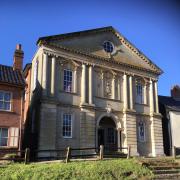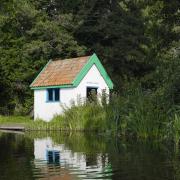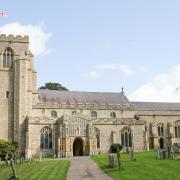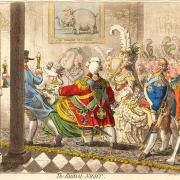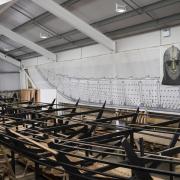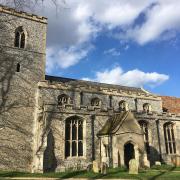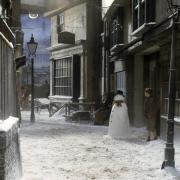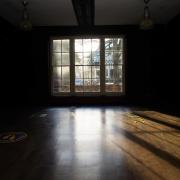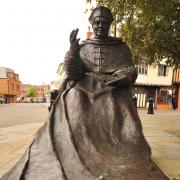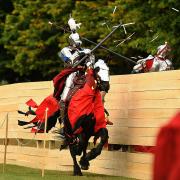When you think of underground tunnels and hidden passages, you tend to think of the miles of tube networks underneath London, or the catacombs beneath Paris. Or even closer to home, right here in Suffolk, it’s well-known there are the remnant of smuggling tunnels underneath the Suffolk town of Hadleigh.
But did you know there’s a whole host of underground tunnels, cellars and even mines beneath Bury St Edmunds?
Local author and historian Martyn Taylor has just finished writing his book, ‘Going Underground: Bury St Edmunds’, in which he’s uncovered a vast variety of tunnels, burial sites, chalk mines, cellars, municipal works, military defences, parch marks and more beneath the historic Suffolk town.

“I have always been fascinated by the chalk mines and tunnels supposedly under Bury St Edmunds,” he explains.
It should come as no surprise that there are tunnels and mines underneath Bury – after all, it was once the home of a magnificent 11th century Abbey, and they had to source the building materials from somewhere.
“The abbey church, once one of the richest and most powerful Benedictine monasteries in England and among the largest in Europe, was built over several generations. The chosen material was flint encased with limestone, the bonding agent lime mortar. Chalk the necessary requirement for this had to be mined deeply and therefore Bury has chalk mines to the east, west and in a central part of town.
“Centuries later, catastrophic consequences occurred when 30 houses that had been built above the chalk mines were affected by property blight and had to be demolished. With the closure of the abbey following the Dissolution of the Monasteries in 1539, there were stories of medieval ghostly figures traversing the town via secret tunnels, unable to rest. Some of their Anglo-Saxon ancestors were discovered in a cemetery when building works were underway on the edge of town” he says.
With this in mind, Martyn spent months working on his book, finding out more about these hidden passageways that lie below. From ancient cellars to Victorian sewers – Bury certainly has layers of intrigue beneath it.
“While collating information on the subjects mentioned within my book, blocked-up doorways in ancient cellars feature prominently with an air of mystery, and the notion of what lay behind them contributing to further anecdotes,” he says.
So what exactly did Martyn find during his research? Here are just a few of the tunnels and mines he uncovered during his research.

The former Masonic Lodge, No. 37 Churchgate Street
Once a well-used coaching inn with roots going back to the seventeenth century, the Six Bells ceased trading in 1885 to become the Masonic hall in 1890. This moved to Ashlar House in Eastern Way, being consecrated in September 2014 with the former lodge converted into luxury apartments.
“During the refurbishment work I was fortunate to be given permission to look into the cellars, which are quite ancient, probably predating the building itself, which was ‘Georgianised’ from at least the middle of the eighteenth century,” Martyn explains.
The 1997 Grade II listing describes: ‘INTERIOR: Extensive cellars run below both parts of the property with walling which includes stone blocks and rubble flint with old render; various brick tunnel vaults.’
“Two interesting facts are mentioned here: stone blocks, which suggest they came from the abbey, and various brick tunnel vaults. After the dissolution, the abbey site was used as a quarry for the town, so this is likely where these blocks originated. The other fact is certainly thought-provoking because on the cellar’s north wall, by means of four small openings in brickwork, a vaulted ceiling can be seen.”
Within the tunnel vaults are items of furniture such as Lloyd Loom chairs and heaters left when this doorway was bricked up post-1997 after the listing had been carried out. A substantial wooden lintel sits above the former doorway.

“Not wishing to propagate many stories about long-lost tunnels under the town, I have been reliably informed by a former mason’s son that as a child he would enter a tunnel via this entrance, going under Athenaeum Lane where it stopped at a metal gate with numerous wine bottles propped against it, on the Angel Hotel side. Wine bins in a cellar for storing wine at constant ambient temperatures are often erroneously associated with tunnel entrances because of their curved construction.
“On another part of the north wall of the cellar there is possibly a further blocked-up doorway. Is the proof of this the wooden lintel, as both sides of the doorway are of rubble construction but in between are bricked up? A classic interpretation of what appears to be an entrance to somewhere once.”

Mount Road Chalk Mines
“The Glen, now a Grade-II property, was put up for sale in 1920 with Miss Ledward a sitting tenant, paying £35 per annum. Surprisingly, there was no mention in the sales particulars of chalk workings being in the grounds. The tunnels to these emanate from a very large pit, which has a brick limekiln,” Martyn explains.
The town’s oldest documented limekiln is in St Andrew’s Street South, dating from 1489.
“Limekilns are recorded on this site with the Warren map of 1791 when the Durrant family were in residence. This limekiln, now possibly the only one in Suffolk, was used as an air-raid shelter during the Second World War and carefully restored by owner John Boughton over the past forty years.
“The town sits on a layer of flint and chalk, calcium carbonate, the process that turns this into calcium oxide, quicklime, requires heat. Chalk is fed into a conical chamber above and combustible material such as charcoal offered up into a fireplace or hearth. Temperatures between 954 and 1,066 °C are required for a chemical reaction to take place. After this you have quicklime. This is mixed thoroughly with water to give ‘slaked’ or hydrated lime, which is left to rest for a period of time, depending on what use you have for it; this lapsed time results in a putty. Generally, one part putty to three parts of sharp sand makes a mortar mix.

“For hundreds of years lime mortar has been used in the building trade until the advent of Portland cement, although it is still crucial for lime mortar to be used on buildings where stonework is in place as it can accommodate stresses caused by building movement without excessive cracking. The actual age of these workings with several tunnels off is hard to determine. The enormous pit had solid chalk hewn out over centuries, possibly for the nearby abbey.”
Vestiges of times gone by have also been found here, as there are gravestones to Gurth (buried 17 February 1867) and Fanny (buried 16 May 1873). These headstones have been mounted on a flint and mortar base, and Martyn speculates they most likely belong to donkeys or pit ponies.
“Incidentally, more animal graves, family pets, belonging to the Cullum family are to be found near the St Nicholas Hospice, Hardwick Lane,” he adds.
Angel Hill
Le Mustowe, known as Angel Hill today, is where the famous Bury Fair was held until it was abolished in 1871.
But could Angel Hill really have a warren of tunnels leading to and from the abbey, as we are led to believe?
This brings us to the story of an intrepid violinist at the end of the eighteenth century who supposedly left Angel Hill from Anderson’s coffee shop on the south side via one such subterranean route, accompanied by other revellers
“Heading in the direction of the abbey, fear overtook his companion’s bravado, and they decided to follow his tune above. Left alone, no more was heard of him – his fiddle was silent. The abbey at Bury was one of the most powerful and impressive in England. All that remains today are the flint core ruins and two massive entrances: the twelfth-century Norman Tower, the religious entrance, and the secular Abbeygate, the second of such due to the rioting townspeople destroying the first in 1327, which was situated opposite today’s Abbeygate Street. The Norman Tower was the first made,” explains Martyn.
“Angel Hill is said to be honeycombed with underground culverts and concealments originating from the abbey, formulating tales of ghostly monks being seen at various times in the cellars of interconnecting shops up nearby Abbeygate Street. Modern-day accounts tell of spectral monks in brown habits being seen, but as the abbey here at Bury St Edmunds housed Benedictine monks, who wore black habits, could people have been confused or mistaken?”
‘Going Under: Bury St Edmunds’ by Martyn Taylor is out August 15 via Amberley Publishing. To find out more, visit Amberley Publishing's website.




